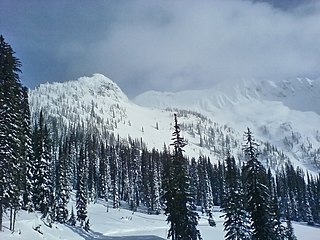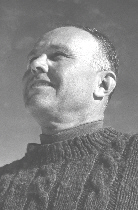
Arapahoe Basin is an alpine ski area in the Rocky Mountains of the United States, in the Arapaho National Forest of Colorado. Arapahoe Basin is known for its extended season—usually staying open until early June, and sometimes into early July, whereas most other northern ski areas close in early April. Arapahoe Basin is located south of Loveland Pass on U.S. Highway 6 in Summit County.

Ski touring is skiing in the backcountry on unmarked or unpatrolled areas. Touring is typically done off-piste and outside of ski resorts, and may extend over a period of more than one day. It is similar to backcountry skiing but excludes the use of a ski lift or transport.

Backcountry skiing (US), also called off-piste (Europe), alpine touring, or out-of-area, is skiing in the backcountry on unmarked or unpatrolled areas either inside or outside a ski resort's boundaries. This contrasts with alpine skiing, which is typically done on groomed trails benefiting from a ski patrol. Unlike ski touring, backcountry skiing can include the use of ski lifts including snowcats and helicopters. Recent improvements in equipment have increased the popularity of the sport.

Aspen Mountain is a ski area in the western United States, located in Pitkin County, Colorado, just outside and above the city of Aspen. It is situated on the north flank of Aspen Mountain at an elevation of 11,212 ft (3,417 m). Aspen Mountain forms the end of Richmond Ridge, a long ridge that extends 10 miles south at approximately 11,000 ft (3,400 m) to join the main spine of the Elk Mountains.

Aspen Highlands is a skiing mountain in Aspen, Colorado. It is famous for the Highland Bowl, which provides what some people consider some of the most intense, wild, and fun skiing in the state. The Aspen Skiing Company operates Aspen Highlands.

Big White Ski Resort, or simply Big White, is a ski resort located 56 km (35 mi) southeast of Kelowna in the Southern Interior of British Columbia. It is located on Big White Mountain, the highest summit in the Okanagan Highland, an upland area between the Monashee Mountains and the Okanagan Valley. Big White is also the largest resort in British Columbia, after Whistler-Blackcomb and Sun Peaks. Moreover, in 2019 Big White was nominated as the third-best ski resort in the nation by Snowpak.

RED Mountain Resort is a ski resort in western Canada, located on Granite, Grey, Kirkup, and Red Mountains in Rossland, a former gold mining town in the West Kootenay region of southeastern British Columbia. RED Mountain is one of the oldest ski hills in North America, with a history dating back to the creation of the Red Mountain Ski Club (RMSC) in the first decade of the 1900s. RED Mountain is located in the Monashee Mountains just north of the U.S. border. Like other ski hills in the British Columbia Interior, it has a reputation for light, dry powder, with yearly snowfall of 750 cm (300 in).
Apex Mountain Resort is a ski resort in southwestern Canada, located in the Okanagan region on Beaconsfield Mountain, just west of Penticton, British Columbia. Its first Pomalift was installed in 1961, with a vertical rise of 370 m (1,200 ft).

Kicking Horse Mountain Resort (KHMR) is a ski resort located 6.4 kilometres (4.0 mi) west of Golden, British Columbia, Canada. It features over 120 trails across more than 3,486 acres (14.11 km2) of skiable terrain and a 1,315-metre (4,314 ft) vertical drop, currently the sixth largest of any North American ski resort. The resort, named after the nearby Kicking Horse River and Kicking Horse Pass, spans the easternmost slope of the Purcell Mountains overlooking the Rocky Mountain Trench. It is located roughly 7 kilometres (4 mi) east of Glacier National Park and 23 kilometres (14 mi) west of Yoho National Park.

Jackson Hole Mountain Resort (JHMR) is a ski resort in the western United States, at Teton Village, Wyoming. In the Teton Range of the Rocky Mountains, it is located in Teton County, twelve miles (20 km) northwest of Jackson and due south of Grand Teton National Park.

Whitewater Ski Resort is a ski resort in western Canada, located a 25-minute drive from Nelson in southern British Columbia. In the Selkirk Mountains, the resort is situated in Ymir bowl, beneath the 2,400-metre-high (7,874 ft) Ymir Mountain. The Selkirks receive plentiful, dry snow, and the location in a high alpine bowl provides an annual snowfall average of approximately 12 m.

Crystal Mountain is a mountain and alpine ski area in the northwestern United States, located in the Cascade Range of Washington, southeast of Seattle.

Breckenridge Ski Resort is an alpine ski resort in the western United States, in Breckenridge, Colorado. Just west of the Continental Divide in Summit County, it is perennially one of the most visited ski resorts in the western hemisphere. Breckenridge is owned and operated by Vail Resorts, Inc.

Vail Ski Resort is a ski resort in the western United States, located near the town of Vail in Eagle County, Colorado. At 5,289 acres, it is the third-largest single-mountain ski resort in the U.S., behind Big Sky and Park City, featuring seven bowls and intermediate gladed terrain in Blue Sky Basin.

The Stevens Pass Ski Area is a ski area in the northwest United States, located at the crest of Stevens Pass in the Cascade Range of Washington. The base elevation is at 4,061 feet (1,238 m) above sea level with the peak at 5,845 feet (1,782 m). The Mill Valley "backside" of the resort drops to a minimum elevation of 3,821 feet (1,165 m). Total skiable terrain includes 37 major runs covering 1,125 acres (4.55 km2).

Telluride Ski Resort is a ski resort located in Mountain Village, Colorado right next to the Town of Telluride.

Whipple Van Ness "Whip" Jones was a ski industry pioneer, founder, developer and the original operator for 35 years, of the Aspen Highlands ski area in Aspen, Colorado. Whip Jones and the company he founded, Aspen Highlands, won a US Supreme Court case against his rival, the Aspen Skiing Company. Jones was also a philanthropist, and was inducted into The Colorado Ski Hall of Fame and The Aspen Hall of Fame for his work with Aspen Highlands.

Ski Cooper is an alpine ski resort in Colorado, one of the oldest in the state. Opened as Cooper Hill Ski Area 80 years ago in 1942, the ski area served as the training site for the 10th Mountain Division, based at nearby Camp Hale during World War II.
Sunday River is a ski resort located in Newry, Maine, in the United States. It is one of Maine's largest and most visited ski resorts. Its vertical drop of 2,340 feet (710 m) is the second largest in Maine and the sixth largest in New England. Sunday River has the most terrain among the East Coast skiing destinations, including eight different peaks. The resort features 135 trails across eight interconnected mountain peaks, and is serviced by a network of 18 lifts.
This glossary of skiing and snowboarding terms is a list of definitions of terms and jargon used in skiing, snowboarding, and related winter sports.
















